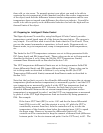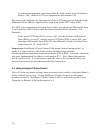38
C4 Manual Rev 7.5.2
4.1 How Intelligent 2 Probe Control functions
Intelligent 2 Probe Control takes advantage of the fact that increasing the
temperature differential between two objects increases the rate of heat transfer
between them. For instance, if a thick and heavy object is to be heated from 0/ to
100/, and the object is placed in a temperature chamber with a 100/ internal air
stream temperature, the temperature of the object will rise quickly at first
because of the large differential between the temperature of the chamber air
stream and the object.
However, as the object continues to absorb heat, the differential decreases and the
rate of heat transfer decreases. The closer the object’s temperature approaches
the air stream temperature, the more slowly the object absorbs heat. To maintain
the thermal transfer efficiency that existed early in the warming process (when
the differential was, for example, 80/), the air stream would have to continually
get warmer as the object heated. When the object was 20/, the air would have to
be 100/, when the object was 50/, the air would have to be 130/, when the object
was 80/, the air would have to be 160/, etc. Heating efficiency can be substantially
improved by this method.
However, because our object is thick and heavy, there likely is a large
temperature differential between the surface temperature of the object and the
core temperature that we are measuring. Even though the object’s core is only 80/
at some point in this process, the surface temperature, exposed to 160/ air, may
well be much higher. In fact, if the object is a poor thermal conductor, the surface
temperature may approach the air temperature... in this example, 160/.
While we would like to have our object’s core temperature increase as quickly as
possible, inducing a surface temperature that is 60/ over the setpoint may be more
than the object can tolerate. If we knew, however, that the object’s surface could
tolerate 130
/, then we could use an air stream temperature of 130/ - but no more -
to speed the transfer of heat into the object.
When the object’s core temperature started to approach the setpoint, we could
reduce the amount of over heating of the air and object surface. The closer the
core temperature got to the setpoint, the less overheating would be applied.
Eventually, just as the core temperature reached the setpoint, the amount of
overheating would be zero. The ramp rate of the core of the object would have
been maximized without exposing any of the object to temperatures exceeding it’s
tolerance.
There is one more consideration. You may want to achieve an object core
temperature as quickly as possible to improve production testing efficiency, but
you may want to not apply thermal differentials that will “shock” the object you
are testing. In fact, the object may have more tolerance for differentials when hot


















